📍 2004 ICC Alpine 3: NER Triumph
🧗♀️ Students: Tim B., Mike E., Jim S.
🧗♀️ Instructors: Ryan Allen
Summary: Good planning and strong students made for a successful climb on Saturday, and a rather leisurely walk out on Sunday.
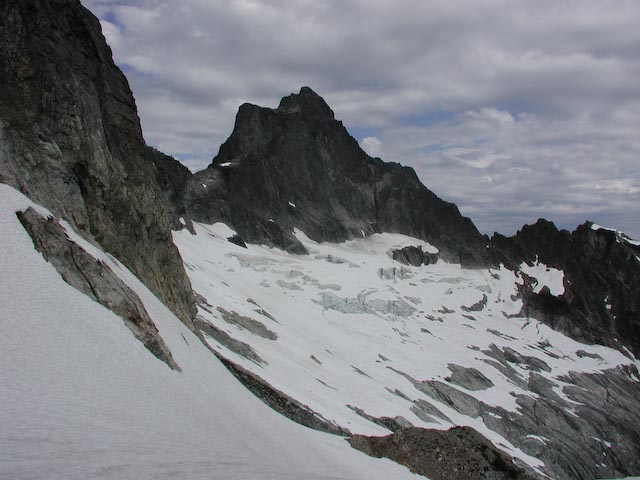
The week before the climb started a very lively and robust discussion about the plan and logistics. It was clear that all three students were on top of the game. The plan evolved to drive in Friday night to get permits, bivvy at the trailhead, hike in Saturday, bivvy on ridge Sat night, finish climb as carryover Sunday and back to cars. Good news, the Marblemount Ranger Station is open until 8 on Friday for permits!
We met at the trailhead Friday night and debated about the weight difference between 14 and 16 slings. Up at 4, started hiking at 4:50. We reached the col past the lakes, after much sweaty work at 10 AM, where we got our first good views of the ridge. We discussed the idea of leaving behind gear and committing to the entire ridge and back to the col tonight. We were all worried about the iffy weather forecast for Saturday night and Sunday. Nobody thought the weight savings would make that much difference and all were worried of being stuck on the ridge, so we decided with 12 hours of daylight left, to go to at least the reported bivvy sites on the ridge and see how fast we were moving. With full packs, we had the safety of bivvying anywhere we could lye down. All the water you can drink was pouring out of the glacier, so we stopped on a rock and drank ourselves silly, filling all our bottles too. It was HOT!
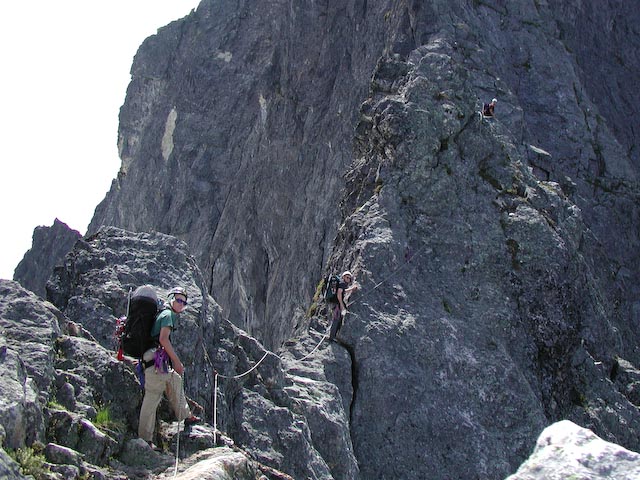
We made the perch just below the notch, roped up and started a 4 person running belay at noon. The route is supposed to be more difficult (5.6 ish) down low, and then eases up until you get to the knife edge just below the 5.7 crux. I wasn’t sure of the others climbing ability, and was a little nervous simuclimbing, so I went last to watch everybody’s technique with heavy packs on. All looked pretty solid, using their feet, working past the slabby initial problems and staying in good balance. It seemed about 30 minutes later, we regrouped at a really cozy looking bivvy with room for all. Is that the top of pitch 2? With 11.5 hours of daylight, and the prospect of bad weather coming, we decided to commit to the rest of the ridge. The climbing was amazingly simple, there was even a strange trail in places. We stayed in running belay mode, for two more running “pitches”. I led out on east trails and low 5th class. After a few hundred feet, we swapped, and Mike took over. The climbing difficulties increased slightly, and included a few short sections and moves that I was slightly nervous on running belay, but we Continued anyhow. Mike led through the knife edge, rather simple climbing, but with amazing, glorious exposure on both sides. We swapped leads again, and I led out another couple hundred feet stopping on a small perch, directly below the 5.7 “off with” crux.
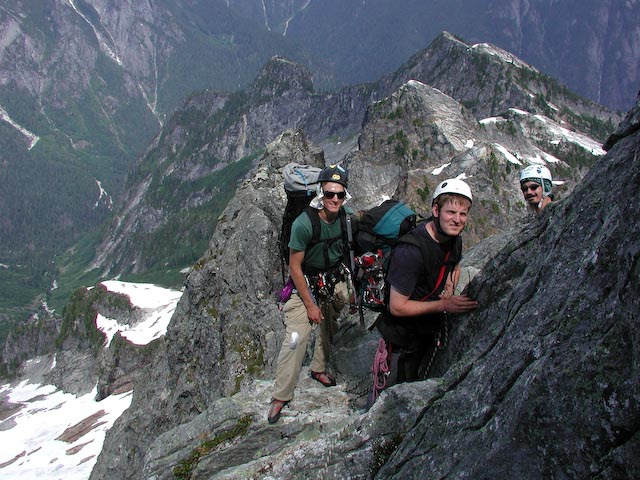
We crowded together on small platform, and discussed what to do next. The climbing was easy, but very spectacular. Tim took the lead. He looked a little shaky in the crux. Legs shaking, protection below his feet, I noticed his foot was between the rope and his pro. Should he fall, he would flip upside sown for sure. I waited for him to get another piece in and yell for him to get his foot on the outside of the rope! He later told me he was not aware of that, nor did he know to be aware of that. It was a little scary. He pulled past it, and surmounted the platform on the top. With the security of the top anchor, the three of us simulclimbed the crux, which was short enough for us to tie in with enough rope between us that only one person was in the critical section at a time.
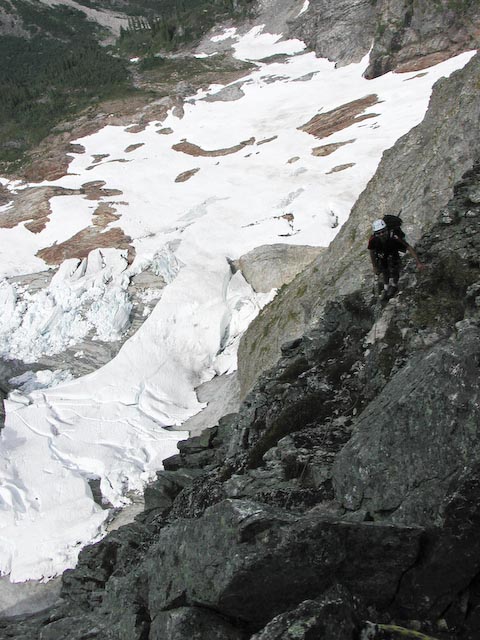
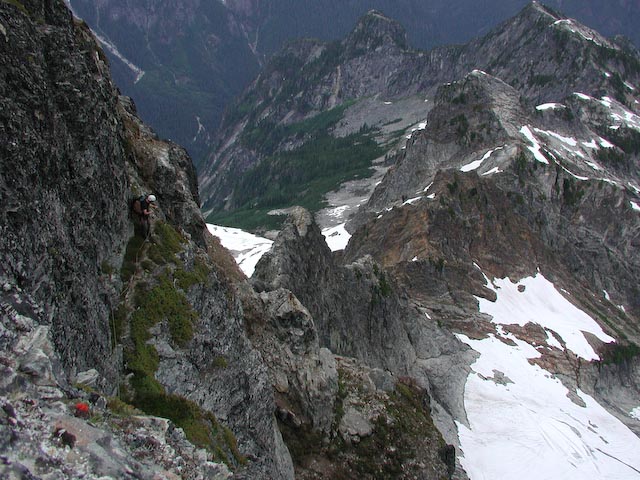
We were feeling pressed for time, so they gave me the lead to continue a running belay to the top. The climbing became easier, around the hump, through the “great notch”, and around the trail to the heather ledges to the top. It was about 500-600 feet of mostly 4th class to the summit.
I did take us off route, just past the Great Notch, some dirty ledges going up to the left put me in a very scary position with no gear and crumbling holds. I groveled and swam through some near vertical dirt, placing me on a trail on the other side. That section would have been easily walked around via trails that go slightly down and around to the left.
Amazing exposure and position!
We reached the summit at 5:15. We estimated we needed 2 hours for the descent, so we intelligently gave us 3 hours for the south ridge descent leaving at 6 PM.
Lounging on the summit.
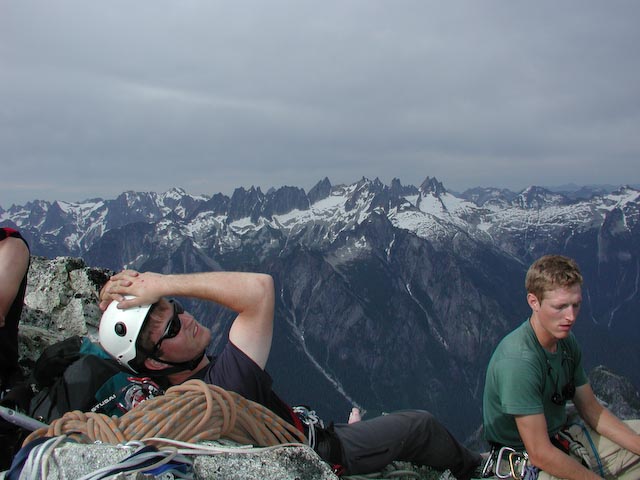
Our descent plan was to follow Jens’s beautifully written S. ridge varation from 1992. We were all very impressed with the descent description, and I’ve included it below with a few additions. Hopefully will keep other party’s from going where we went! On the second to last rappel, I went first. We were supposed to find some sandy ledges. I went to the end of the two 60 M ropes to a small grassy gully that appeared to have a walk to the south. I yelled “OFF!” and started looking for the way down. I walked around a small corner and stopped on a small sloping perch. With no rappel anchors in sight, I got on my belly and stuck my head over the edge, knocking a softball rock off. “CLUNK…” one-one thousand, two-one thousand, three-one thousand, four…”CLUNK clunk clunk.” I was unroped, off route in no man’s land, teetering over The Void. It must have been 500-600 feet of air under me. I looked up to the left and saw what appeared to be a sandy ledge system to easy ground. I started climbing up there, moving into more difficult moves. Looking over my shoulder I asked myself “What are the consequences if???”. The answer was clearly “It All”. I grabbed the rope and bat-manned out of there with a contrived prussick / teeth technique. Jim had since rapped down to a platform about 10 feet above me, and directed Mike to go way left. After about an hour of prussicing practice, we all made it to the ledge where Mike was. The sun was setting quickly, and we wanted to find the final rap anchors before dark. One more 20 foot rap put us directly on a long flat section of the S ridge. Tim and I were moving as rapidly as we could, S to the reported polished granite. A good 800 to 1000 feet of “butt scrambling” down toward the glacier and still no anchors in sight. We finally found one, that was easily within one rappel from the glacier. However, it required 5.6 friction traverse to get to it. Tim, still wearing rock shoes soloed over and we rigged a system with a cord-a-lette to pull the rap rope over to us. The 4 of us made the firming glacier at 10 PM, in a slight drizzle. Crampons and ice axes got us back to the col at 11PM. Sighs of relief were everywhere as boots came off and plentiful water was drunk. It had been an 18 hour day. I was totally wasted. We slept in until about 9 AM, and left camp at 10:30. What a luxury it is to sleep in on alpine climbs! We were back at the cars at 2:30. It had rained on and off all day.
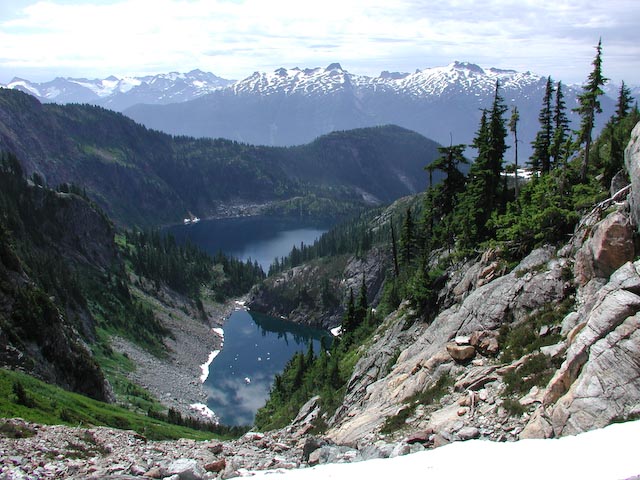
Summary: What a great climb! The students were solid, had a thorough understanding of what the constraints were, and played out many different, reasonable and some un-reasonable scenarios before and throughout the climb. Everybody was quick to adapt to new and sometimes experimental techniques. Everybody was situationaly aware, especially as the day was coming towards the end, and all wanted to participate in solving the problems presented. It was a beautifully planed and executed climb, working around the weather forecast and giving us a leisurely Sunday! A very memorable and fun climb!!
Jen’s 2002 descent description, with a few added comments:
Since we could not find a very detailed description of the descent down the south ridge, we’ll give some detail here.
We walked south from the summit, and sure enough, a south facing gully appeared. We could see a sling at the top of it, but the terrain below it didn’t seem all that difficult, so we decided to go a little further down. After about 100 ft from the top of the gully we found another anchor. We did a double rope rappel down the now steeper gully. It was vertical at first, but gradually got onto easier terrain, so it was a bit of a toss up where to get off rappel.
2004 team> It was much quicker to just rappel right off the end of our ropes. The scrambling was still a bit steep and slow. We continued down climbing easy terrain until a tower appeared in front of us. Here it was tempting to go to the left (east) of the tower down easy terrain, but the rappel was actually to the right (ne) of the tower. It is kinda hard to spot, tucked around the corner to your right (climbers left).
After the team had spent some time converting Brent’s left and right into climber’s right, rappeller’s left, and scrambler’s straight ahead, Jens rapped first. It was a little wild — a free rappel into the abyss — a narrow, vertical chute obscured with clouds and mist. Kara was thinking about if the rope came off she would just smash to bits, while Brent was whooping and hollering on his trip down. After a while, the rap hit a small ledge with rock and scree, then continued down another short vertical step until the gully flattened out into more sand and scree. Here we got off rappel and climbed out of the gully on narrow grassy ledges leading out to the east (climbers right).
2004 team> Yup, that was just about as accurate as can be. The rappel was hardly free, I was expecting something like monkey face, or the last two rappels of “Sea of Dreams” on El Capitian. My feet were always within 2 inches from the wall. Careful! We got the rope stuck on the far wall of the gully on the throw down! Also, the pull was _Very_ difficult. It took us about an hour to un stuck the rope here.
From here, we scrambled down about 100ft, until we found another anchor with many slings. This rappel went off the east face, to a sandy ledge. With our 50 meter ropes, Tom had just barely reached those ledges. Other parties have cut this rappel in two, and done the last 15 feet as a single rope rappel. The sandy ledge goes around the corner to the south and on to easier terrain. Jens found the step around the corner quite exposed and exciting, Kara didn’t notice it at all.
2004 team > It was that exposed step that I was trying to solo to. I was directly below it! We did this in 2 rappels, and had 60 meter ropes. We were afraid of another stuck rope and the sun was setting fast. When rappelling, stay as far to the rappeler’s left as reasonable. There is a large, wide and slightly sloping platform just before sandy ledges. The final 15 foot rappel is directly in a narrow gully and a bit awkward. NOTE: This puts you directly on the long flat and wide section of the south ridge!
From there we just walked down the now pretty flat ridge over and around a small hump, until the obvious notch. Here we started scrambling down polished granite slabs. Climbing was generally easy using cracks and steps down. Even with full backpacks and boots, it didn’t feel too bad. We followed the wall to our right (climbers left) and about 2/3 down, we saw some rap slings. We assumed these were the ones used by Terry and Prash two weeks before. But we weren’t confident that we could reach the glacier from those with our 50 meter ropes, remembering that they had had some trouble with their two 60s. So we climbed down a step, and then down more slabs that were now getting pretty exposed. We then got to a very exposed “blind” step down. After taking a look at it, we decided that none of us would be very comfortable doing that unroped, so we started looking for a way to set up a small belay. But no natural pro was available, and we weren’t too keen on getting out the rack. What to do? The solution was found by Kara, in the form of a large chock stone under the wall to the right. Brent traversed over to it, gave it a couple of good kicks, and then set a new personal best time for water knots tying a sling around it. We had a solid anchor, and we were less than 50 meters from the glacier. Time to rappel! This rappel brought us comfortably down to the glacier, which had conveniently provided us with a lip to cross the sizable moat.
2004 team > Yup, very well described. The rap anchor we finally found was about 35-40 meters above the glacier. It was a chock-stone wedged directly in the bottom of the (climbers) right facing wall that you follow down the slabs. It was difficult to find, and you keep descending further than you think.
